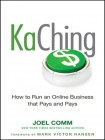KaChing: How to Run an Online Business that Pays and Pays Comm, Joel (books for 8th graders txt) 📖

Book online «KaChing: How to Run an Online Business that Pays and Pays Comm, Joel (books for 8th graders txt) 📖». Author Comm, Joel
Only 3 percent chose a merchant based on its relevance to their web site. That might explain why almost half of those affiliates were earning less than $500 a month. However, 4 percent were making between $10,000 and $20,000 a month, and 17 percent said that they were making more than $20,000 every month. If you get your affiliate system right, you really can make your business KaChing! But you have to get it right.
That starts with choosing your merchants.
You really have a choice of two different routes. Affiliate networks like Commission Junction and ClickBank act as clearing-houses for merchants. You can browse around, look for a product that suits your content, and add it to your site.
This approach works best when you have lots of sites on lots of different topics and are hoping that affiliate revenues will give you a little extra each month. From the publisher’s point of view, the process couldn’t be simpler: Sign up, pick a product, and place the ad on your page. Whatever sales you earn will be a nice little bonus and could mount up when placed across a large network of different sites.
The alternative is to take the ads directly, either from a trusted retailer or from the producer. I’ve already explained how you can create your own affiliate network to promote your product, but not all producers do this, especially when their products are physical. While creators of handcrafted wooden toys might be fine about shipping off their goods to occasional buyers brought in by affiliates, large producers usually prefer to send their products in bulk to a wholesaler or to large retailers. They then rely on those businesses to bring in the buyers.
If you want to sell an information product, it’s likely that you’ll be able to join the producer’s own affiliate program. If you want to offer the kind of product you can find in stores, you’ll probably be looking at the affiliate programs of major retailers—giving you a bit of a headache as you try to weigh up the benefits of each.
Whichever approach you take—whether you’re looking at an affiliate network or the programs of different retailers—you’ll find there are lots of different criteria that you can use to judge their programs. Different affiliate merchants will offer different sales percentages, have different kinds of ads, provide different minimum payout levels, and offer customer service of variable quality.
All of those things are important. But none of them are as important as whether your customers trust the merchant enough to buy.
With a maximum commission of just 15 percent, Amazon has one of the lowest-paying affiliate systems (Figure 5.1). Yet its program is also one of the most popular, partly because it offers a huge range of products, but mostly because people trust the company. If they’ve bought from Amazon before, they understand how it works, and they know that it won’t pocket their credit card details for nefarious purposes.
Figure 5.1Amazon’s Associates program lets you offer any of the company’s products in a huge range of different ways... for a commission of up to 15 percent. In practice, the commission is usually much lower.
Put an affiliate ad from Amazon on your site, and the trustworthiness of the merchant isn’t an issue. The only remaining challenge will be whether you can persuade your users that the product is worth buying.
You can spend a huge amount of time browsing affiliate networks in your search for the perfect merchant for your site. You can lose hours comparing commission rates, reading reviews from other sellers, and trying to second-guess the kind of service you’ll get from the merchant’s affiliate manager. But when you’re using affiliate products as an additional sales channel to complement your other methods of generating a KaChing, the most important factor will be the ease with which you can move users from browsers to buyers. You want to make sure that there are as few obstacles as possible on the way to the cash desk. That means choosing a merchant you believe will be familiar to your users and one with whom they’re used to doing business.
Usually, that’s pretty clear. If you want to promote a book on a topic related to the subject of your article, then it’s likely that Amazon will be the most trusted retailer. Things get a little more complex when you have a real choice between similar outlets offering competing affiliate programs. Photographers, for example, can now earn a little money by submitting their images to microstock sites, which license them to publishers in return for a fee. Each of those sites has an affiliate program that reflects the sorts of users it needs most. iStockphoto (www.istockphoto.com), the most popular microstock site, pays a one-time $10 bounty for new customers and nothing for new photographers. BigStockPhoto (www.bigstockphoto.com) pays $5 for new photographers and 35 percent of the value of the first sale for new buyers. Dreamstime (www.dreamstime.com) has the potential to be the most lucrative of all: It pays affiliates 10 percent of what referred photographers earn and what referred buyers spend for up to three years.
It might seem that Dreamstime’s affiliate program offers the best deal. But if photographers don’t feel that Dreamstime will sell their photos, then they won’t sign up. And if buyers don’t feel that Dreamstime offers them a wide enough selection of pictures, then they won’t buy any.
When that happens, affiliates earn 10 percent of nothing.
Similarly, a site with content aimed at photographers, but has very few images for buyers wouldn’t make much money promoting iStockphoto, which pays nothing for new photographers.
These sorts of choices turn up across different fields. Amazon’s Associate program is very different from that offered by Borders or the one offered by Barnes & Noble. While Borders pays according to a performance scale that tops out at 8.5 percent, Barnes & Noble pays a flat 6 percent. Amazon, with its front-page 15 percent boast, actually makes the choices even more complicated by





Comments (0)